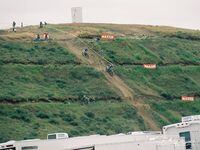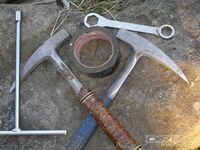Between dirt bike riding and my job as a geotechnical engineer I spend most of my time looking at the ground. Geotechnical engineers are part geologist and part engineer and we work with the ground and build things with it, or on it. This has some great perks. Ever look at a construction site and think man it would be awesome to ride it. Done that!I saw a Bridgestone ad in last month's issue of DR that said "If you think all dirt is the same, see a geologist or a serious rider". I thought, "wow somebody else gets it."Dirt riders are skilled in many areas. Geology is just one of the specialties dirt riding requires, but there are many more. Timber clearing is another. Riders like Paul Ostebo carry huge chain saws on the front of their bikes; maintaining a blistering pace and clearing fallen logs from the trail while they ride. But that is another story. This is about geology and I have constantly been amazed at just how much this impacts riding, and at the geology skills of riders.When we prepare for a ride we always consider the geologic conditions of the area. We know that subtle differences in the texture can have a big impact on performance and increase or decreases the potential for bike damage. An experienced rider knows that they are never just riding on plain dirt. The ground we ride on is made up of rock, silt, sand, or clay with all kinds of mixtures, moistures, and hardness's. By necessity riders become pretty darn good geologists, or let's say "moto-geologists". We use our geologic skills to decide on tire selection, goggle set up, suspension settings, air filter layers, bike protection, and how hard to gas it; just to name a few items. Ignore the geologic conditions of where you are riding and you may have nothing but problems for the day. Study it and plan for it and you will be in sync with the earth. Riders who don't become "moto-geologists" get tired of breaking and crashing and eventually move on to an indoor sport, like swimming, where water is always water.The best riders have PhD's in moto-geology take Ricky Carmichael he studies the ground that a track is made from and finds the fastest geologic line. As a geotechnical engineer I occasionally have to make fast geologic decisions on whether to open or close a road that involves a geologic hazard such as a landslide. Desert racers like Johnny Campbell judge geologic hazards at 100 mph for miles on end. Johnny can catch a glimpse from a single crystal sparkle in a sea of sand, and instantly changes course knowing that the crystal sparkle is a warning signal from a geologic hazard, the tip of an unforgiving basketball size boulder, lying just below the surface.Since dirt is not just dirt, maybe dirt riding does not seem like the best description of what we do, but it is hard to imagine sitting down and reading Geology Rider Magazine.
Latest




/cloudfront-us-east-1.images.arcpublishing.com/octane/ZJPPRO5CRNFYPEVMWIFR7RRFQQ.jpg)
/cloudfront-us-east-1.images.arcpublishing.com/octane/MMAOLEHZG5CBXAOICNKNGCEK4I.jpg)
/cloudfront-us-east-1.images.arcpublishing.com/octane/KQUVDTNB6VF53CRDNN47BE3VUA.jpg)
/cloudfront-us-east-1.images.arcpublishing.com/octane/3T32INAZQRGPXOGGA36NQJDSSM.jpg)
/cloudfront-us-east-1.images.arcpublishing.com/octane/EPLS5PBKXBHNXK7S5O7G4ND3YQ.jpg)
/cloudfront-us-east-1.images.arcpublishing.com/octane/MNGOZAGZFZBH5DPFV7NOPF5S3Y.jpg)
/cloudfront-us-east-1.images.arcpublishing.com/octane/VGJWIIFM2VBCXG34KRQ37GCP7U.jpg)
/cloudfront-us-east-1.images.arcpublishing.com/octane/2ZU3HXRPMZESJF7HDLZJV7FHEY.jpg)
/cloudfront-us-east-1.images.arcpublishing.com/octane/VVFWQBZEIZDVJHZIW5ISKWKOZU.jpg)
/cloudfront-us-east-1.images.arcpublishing.com/octane/7T7FZXHIIBDX7AOBD5S3IICUJI.jpg)
/cloudfront-us-east-1.images.arcpublishing.com/octane/T3Y7A52TXBEBJNEPGOQSVPQSPU.jpg)
/cloudfront-us-east-1.images.arcpublishing.com/octane/KY33U3WBTNFIBJFMTEF2SM7BOQ.jpg)
/cloudfront-us-east-1.images.arcpublishing.com/octane/JNPS5MGVXJC7BARVMARYQIQHXE.jpg)
/cloudfront-us-east-1.images.arcpublishing.com/octane/63N2P6SYAZDURJDO5KARQYX2J4.jpg)
/cloudfront-us-east-1.images.arcpublishing.com/octane/C72WX35SXFETTO5OVA2RWT523I.jpg)
/cloudfront-us-east-1.images.arcpublishing.com/octane/F3ER37EV2RGY5CRYFNTWE3JSF4.jpg)
/cloudfront-us-east-1.images.arcpublishing.com/octane/L65QCUR32RH2NKCUHXYHHAPDFI.jpg)
/cloudfront-us-east-1.images.arcpublishing.com/octane/VSK246VVRRDMBNQU7B2NTNY6AE.jpg)
/cloudfront-us-east-1.images.arcpublishing.com/octane/CG64RRFAYRENNAP2AA22T2LSJY.jpg)
/cloudfront-us-east-1.images.arcpublishing.com/octane/IKZSRLBWMRDORMORBXSISL4D6M.jpg)
/cloudfront-us-east-1.images.arcpublishing.com/octane/BJLVRPJSDFC3ZLPMW3LYYHMPZE.jpg)
/cloudfront-us-east-1.images.arcpublishing.com/octane/RQW2RFU4MJDYRPVFJNW362SEXU.jpg)
/cloudfront-us-east-1.images.arcpublishing.com/octane/CGQDU7HEEBBWBLF6SMXCJIW7DI.jpg)
/cloudfront-us-east-1.images.arcpublishing.com/octane/B35XXACE4ZGU5BWSEMEFUL6SN4.jpg)